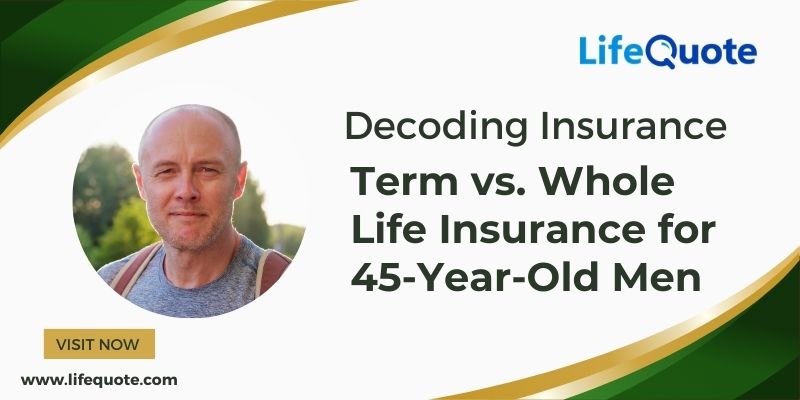Decoding Insurance: Term vs. Whole Life Insurance for 45-Year-Old Men

Introduction:
Insurance is a vital aspect of financial planning, particularly as one ages and takes on more responsibilities. For 45-year-old men, determining the right insurance type can be pivotal in securing their family’s financial future. Two primary options often considered are term life insurance and whole life insurance. In this blog, we’ll delve into the intricacies of both, helping you understand which might be the best fit for your needs at this stage in life.
Understanding Term Life Insurance:
Term life insurance provides coverage for a specific period, typically ranging from 10 to 30 years. It offers a death benefit to beneficiaries if the insured passes away during the policy term. Here are some key points to consider:
Affordability: Term life insurance tends to be more affordable than whole life insurance, making it attractive for individuals looking for high coverage at a lower cost. This can be especially beneficial for 45-year-old men who may have significant financial obligations like mortgages or children’s education expenses.Flexibility: Term policies offer flexibility in terms of coverage duration. You can choose a term that aligns with your financial responsibilities, such as until your children are grown or until your mortgage is paid off.Limited Coverage: The downside of term life insurance is that it only provides coverage for the specified term. If the insured outlives the policy, there is no payout, and coverage must be renewed, often at a higher premium due to increased age and potential health issues.
Understanding Whole Life Insurance:
Whole life insurance, on the other hand, provides coverage for the insured’s entire life, as long as premiums are paid. It also includes a cash value component that accumulates over time. Here’s what you need to know:
Lifelong Protection: Whole life insurance offers lifelong protection, which can be reassuring for individuals who want to ensure their loved ones are financially secure regardless of when they pass away.Cash Value Growth: A portion of the premiums paid into a whole life policy goes towards building cash value. This cash value grows over time on a tax-deferred basis and can be accessed through loans or withdrawals for various financial needs.Higher Premiums: Whole life insurance typically comes with higher premiums compared to term life insurance due to its lifelong coverage and cash value component. This can be a consideration for 45-year-old men who may have budget constraints.
Choosing the Best Option:
Determining whether term or whole life insurance is best for a 45-year-old man depends on individual circumstances, financial goals, and risk tolerance. Here are some factors to consider:
Financial Responsibilities: Evaluate your current and future financial obligations, such as mortgage payments, children’s education expenses, and retirement savings needs. Choose a policy that aligns with these responsibilities.Budgetary Constraints: Consider your budget and how much you can afford to allocate towards insurance premiums. While whole life insurance offers lifelong coverage and cash value growth, it may not be feasible for everyone due to its higher cost.Risk Tolerance: Assess your risk tolerance and financial goals. If you prioritize low-cost coverage with the option to invest elsewhere, term life insurance may be the better choice. If you seek lifelong protection and the ability to build cash value over time, whole life insurance could be suitable.
Conclusion:
For 45-year-old men, selecting the right life insurance option involves careful consideration of various factors, including financial responsibilities, budgetary constraints, and risk tolerance. While term life insurance for old men offers affordable coverage for a specific period, whole life insurance provides lifelong protection and cash value growth. By understanding the differences between the two, individuals can make an informed decision that best meets their needs and secures their family’s financial future.






